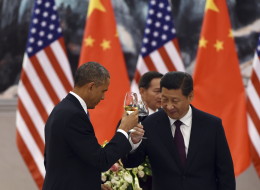The climate deal between the US and China is a historic moment. It's not enough to match the scale of the climate crisis, but it's implications for extreme energy projects like Canada's Tar Sands are major. Here are five reasons why.
Source: huffingtonpost.ca/
Author: Cameron Fenton
1. The Deal Reinforced Political Commitments to the 2°C Warming Limit.
In announcing their climate deal, the US and China committed to "the longer range effort to transition to low-carbon economies, mindful of the global temperature goal of 2℃", referencing the ceiling for warming agreed upon at the Copenhagen climate talks in 2009. With the world already close to crossing the 1℃ threshold, the prospects of 2℃ are dire. Even so, according to the International Energy Agency, current tar sands developments are on track to be triple the size they can be under a 2℃ limit, meaning that this deal also reinforces the reality that tar sands expansion are incompatible with global climate action.
2. It Highlights Canada's Plan to Blow Our Climate Targets
Tar sands emissions have doubled since 1990 and are on projected to double again by 2020, making the tar sands Canada's fastest growing source of emissions. This growth is the main reason Canada is set to miss our pledge to cut emissions 17 per cent below 2005 levels by the year 2020. This target was in line with United States' commitmentsuntil the US increased it's commitments to reduce emissions event more in the deal with China. The Canadian government projects that Canada's emissions will rise by nearly 40 per cent by 2030, the same year that China has committed to have its emissions peak by.
3. It Makes Canada's Lack of Regulation Even More Ridiculous
Despite claims from industry that the tar sands are home to "world class" regulation and monitoring, Canada remains without any federal climate policy regulating oil and gas development. Regulations have been promised since 2006 but never delivered, leaving Canada with no climate plan, or policy to regulate emissions. At the same time, projects like the Energy East pipeline, with a climate impact the same a 7 million cars, are being pushed through without any review or consideration of climate impacts. Without even basic regulations, Canada's tar sands are on track to undermine the shift towards the "deep decarbonization pathway" pledged in the US-China climate plan.
4. It Raises Questions About the Viability of Pipeline Proposals
Planned and projected tar sands growth, and it's dangerous implications for the climate, depend on pipeline projects like the Keystone XL, Energy East and Northern Gateway pipelines. These pipelines are being built for the primary purpose of exporting tar sands crude to US and Asian markets. The US-China climate deal, and the commitments to clean energy development within it, mean that Canada is pushing projects into markets pledging to move away from dirty energy.
5. It Reinforces Keystone XL as Obama's Climate Test
The short term political impact of this deal still remains to be seen. While this is a strong message of the US and China's intention to take climate action, the proof remains to be seen. With the deepening climate crisis at the point it's at today, there are no points left for political leaders to simply make promises, they need to follow through with concrete actions. For Barack Obama to make this more than a paper promise, he needs to reject the Keystone XL pipeline, and for politicians in Canada, a similar climate test is shaping up around Energy East.
The bottom-line is that this new deal between China and the United States highlights the reality that Canada and the tar sands are going the wrong direction when it comes to tackling climate change.
Original Article
Source: huffingtonpost.ca/
Author: Cameron Fenton

No comments:
Post a Comment